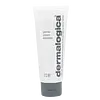What's inside
What's inside
 Key Ingredients
Key Ingredients

 Benefits
Benefits

 Concerns
Concerns

 Ingredients Side-by-side
Ingredients Side-by-side

Water
Skin ConditioningDiatomaceous Earth
AbrasiveButylene Glycol
HumectantC12-15 Alkyl Benzoate
AntimicrobialPrunus Armeniaca Kernel Oil
MaskingPapain
Skin ConditioningBromelain
Skin ConditioningSteareth-21
CleansingSteareth-2
EmulsifyingCetearyl Alcohol
EmollientSalicylic Acid
MaskingSodium Magnesium Silicate
Lactic Acid
BufferingAloe Barbadensis Leaf Extract
EmollientCentaurea Cyanus Flower Extract
AstringentCitrus Medica Limonum Fruit Extract
Skin ConditioningCitrus Aurantium Dulcis Flower Extract
Skin ConditioningChamomilla Recutita Flower Extract
MaskingPolysorbate 80
EmulsifyingDisodium EDTA
Benzyl PCA
HumectantPhenoxyethanol
PreservativeLinalool
PerfumingLavandula Angustifolia Oil
MaskingCI 77891
Cosmetic ColorantWater, Diatomaceous Earth, Butylene Glycol, C12-15 Alkyl Benzoate, Prunus Armeniaca Kernel Oil, Papain, Bromelain, Steareth-21, Steareth-2, Cetearyl Alcohol, Salicylic Acid, Sodium Magnesium Silicate, Lactic Acid, Aloe Barbadensis Leaf Extract, Centaurea Cyanus Flower Extract, Citrus Medica Limonum Fruit Extract, Citrus Aurantium Dulcis Flower Extract, Chamomilla Recutita Flower Extract, Polysorbate 80, Disodium EDTA, Benzyl PCA, Phenoxyethanol, Linalool, Lavandula Angustifolia Oil, CI 77891
Water
Skin ConditioningGlycerin
HumectantAmmonium Lauryl Sulfate
CleansingLactic Acid
BufferingDecyl Glucoside
CleansingSodium Hydroxide
BufferingXanthan Gum
EmulsifyingEthylhexylglycerin
Skin ConditioningCarrageenan
Panthenol
Skin ConditioningTocopherol
AntioxidantGlucose
HumectantPhenoxyethanol
PreservativeLycium Barbarum Fruit Extract
AstringentParfum
MaskingArginine
MaskingVinegar
Propylene Glycol
HumectantAlcohol
AntimicrobialRubus Idaeus Extract
Skin ProtectingAscophyllum Nodosum Extract
Skin ConditioningSodium Benzoate
MaskingCitric Acid
BufferingPotassium Sorbate
PreservativeWater, Glycerin, Ammonium Lauryl Sulfate, Lactic Acid, Decyl Glucoside, Sodium Hydroxide, Xanthan Gum, Ethylhexylglycerin, Carrageenan, Panthenol, Tocopherol, Glucose, Phenoxyethanol, Lycium Barbarum Fruit Extract, Parfum, Arginine, Vinegar, Propylene Glycol, Alcohol, Rubus Idaeus Extract, Ascophyllum Nodosum Extract, Sodium Benzoate, Citric Acid, Potassium Sorbate
Ingredients Explained
These ingredients are found in both products.
Ingredients higher up in an ingredient list are typically present in a larger amount.
Lactic Acid is another well-loved alpha hydroxy acid (AHA). It is gentler than glycolic acid but still highly effective.
Its main role is to exfoliate the surface of the skin by loosening the “glue” that holds dead skin cells together. Shedding those old cells leads to smoother, softer, and more even-toned skin.
Because lactic acid molecules are larger than glycolic acid, they don’t penetrate as deeply. This means they’re less likely to sting or irritate, making it a great choice for beginners or those with sensitive skin.
Like glycolic acid, it can:
Lactic acid also acts as a humectant (like hyaluronic acid). It can draw water into the skin to improve hydration and also plays a role in the skin's natural moisturizing factor (NMF) in the form of sodium lactate.
Studies show it can boost ceramide production to strengthen the skin barrier and even help balance the skin’s microbiome.
To get results, choose products with a pH between 3-4.
Lower strengths (5-12%) focus on surface exfoliation; higher strengths (12% and up) can reach deeper in the dermis (deeper, supportive layer) to improve skin texture and firmness over time.
Though it was originally derived from milk, most modern lactic acid used in skincare is vegan. It is made through non-dairy fermentation to create a bio-identical and stable form suitable for all formulations.
When lactic acid shows up near the end of an ingredient list, it usually means the brand added just a tiny amount to adjust the product’s pH.
Legend has it that Cleopatra used to bathe in sour milk to help reduce wrinkles.
Lactic acid is truly a gentle multitasker: it exfoliates, hydrates, strengthens, and brightens. It's a great ingredient for giving your skin a smooth, glowing, and healthy look without the harshness of stronger acids.
Read more about some other popular AHA's here:
Learn more about Lactic AcidPhenoxyethanol is a preservative that has germicide, antimicrobial, and aromatic properties. Studies show that phenoxyethanol can prevent microbial growth. By itself, it has a scent that is similar to that of a rose.
It's often used in formulations along with Caprylyl Glycol to preserve the shelf life of products.
Water. It's the most common cosmetic ingredient of all. You'll usually see it at the top of ingredient lists, meaning that it makes up the largest part of the product.
So why is it so popular? Water most often acts as a solvent - this means that it helps dissolve other ingredients into the formulation.
You'll also recognize water as that liquid we all need to stay alive. If you see this, drink a glass of water. Stay hydrated!
Learn more about Water